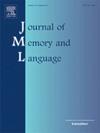What’s in my cluster? Evaluating automated clustering methods to understand idiosyncratic search behavior in verbal fluency
IF 3
1区 心理学
Q1 LINGUISTICS
引用次数: 0
Abstract
Individuals routinely search through memory for concepts. This behavior is commonly studied via the verbal fluency task (VFT), where participants are typically asked to generate as many exemplars as they can from a given category (e.g., animals) or letter label (e.g., F) within a fixed amount of time. Responses in the VFT tend to be clustered in meaningful ways but individuals widely differ in the manner in which they cluster items. Despite the development of several (hand-coded and automated) methods of defining clusters and switches in the VFT, there is currently no consensus on which scoring method provides the best mechanistic account of how individuals search through memory in the VFT. In this work, we provide an empirical evaluation of several automated methods for defining clusters and switches in the VFT by comparing model-predicted clusters with participant-designated clusters. We find that a method that combines gradual rises and drops in a weighted composite of semantic and phonological similarity best predicts participant-designated cluster-switch events across three domains (animals, foods, and occupations). Furthermore, we propose a novel approach to understand idiosyncratic search behavior by computing a measure of discordance for each pairwise transition based on a large dataset of cluster-switch designations from independent raters (N = 211) for the same transitions via a pre-registered experiment. We find that transitions with high idiosyncratic scores have low lexical content (i.e., semantic and phonological similarity), and an individual’s score on one domain is predictive of their score on another domain, suggesting that idiosyncratic scores may be capturing meaningful information about non-lexical sources and processes that contribute to memory search at the individual level.
我的集群中有什么?评估自动聚类方法来理解语言流畅性中的特质搜索行为
个人通常会在记忆中搜索概念。这种行为通常通过言语流畅性任务(VFT)来研究,参与者通常被要求在固定的时间内从给定的类别(如动物)或字母标签(如F)中产生尽可能多的例子。VFT中的反应倾向于以有意义的方式聚集在一起,但个体在聚集项目的方式上差异很大。尽管开发了几种(手工编码的和自动的)方法来定义VFT中的簇和开关,但目前还没有就哪种评分方法能够提供最佳的机制描述个体如何在VFT中搜索记忆达成共识。在这项工作中,我们通过比较模型预测的聚类和参与者指定的聚类,对几种用于定义VFT中的聚类和开关的自动化方法进行了实证评估。我们发现,一种结合语义和语音相似性加权组合的逐渐上升和下降的方法,可以最好地预测参与者指定的跨三个领域(动物、食物和职业)的群集切换事件。此外,我们提出了一种新的方法来理解特质搜索行为,通过预注册实验,基于独立评分者(N = 211)的集群切换指定的大型数据集,计算每个成对转换的不一致性度量。我们发现,具有高特质分数的过渡具有低词汇内容(即语义和语音相似性),并且个体在一个领域的分数可以预测他们在另一个领域的分数,这表明特质分数可能捕获有关非词汇来源和过程的有意义的信息,这些信息有助于在个体层面上进行记忆搜索。
本文章由计算机程序翻译,如有差异,请以英文原文为准。
求助全文
约1分钟内获得全文
求助全文
来源期刊
CiteScore
8.70
自引率
14.00%
发文量
49
审稿时长
12.7 weeks
期刊介绍:
Articles in the Journal of Memory and Language contribute to the formulation of scientific issues and theories in the areas of memory, language comprehension and production, and cognitive processes. Special emphasis is given to research articles that provide new theoretical insights based on a carefully laid empirical foundation. The journal generally favors articles that provide multiple experiments. In addition, significant theoretical papers without new experimental findings may be published.
The Journal of Memory and Language is a valuable tool for cognitive scientists, including psychologists, linguists, and others interested in memory and learning, language, reading, and speech.
Research Areas include:
• Topics that illuminate aspects of memory or language processing
• Linguistics
• Neuropsychology.

 求助内容:
求助内容: 应助结果提醒方式:
应助结果提醒方式:


